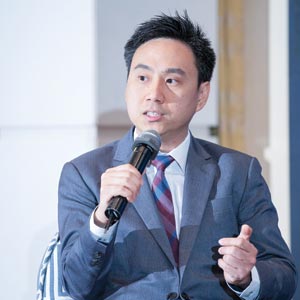THANK YOU FOR SUBSCRIBING

The Digital Utility Powering the Next Generation
Henry Bailey, Global VP, Utilities IBU, SAP [NYSE:SAP]


Henry Bailey, Global VP, Utilities IBU, SAP [NYSE:SAP]
The utilities industry is quickly becoming very dynamic and fast moving like never before. Digital disruption impacts all lines of business, bringing with it opportunities and challenges.
Utilities have been affected by the expansion of renewable energy, a surplus of distributed generation and advancements in battery storage. In addition, new customer engagement behavior and disruptive business models have been accelerated by the Internet of Things (IoT) which are now affecting how utilities will power the next generation.
Imagine a young, 26 year old executive sitting in their office overlooking the New York City skyline admiring a clear day in Manhattan. Below, almost all of New York City’s taxi cabs are electric vehicles. A new type of energy source is a few blocks away providing abundant electricity to power transportation in a city where the ever growing population is driven by urbanization. Some experts also say the electric taxi prevented a catastrophic environmental disaster from occurring in New York City.
Does this story take place 20 years into the future? It’s hard to believe, but it actually took place over 100 years ago in 1899. And the catastrophic environmental disaster? Solid waste from thousands of horses used for transportation in New York City at the turn of the century. In 1899 and 1900, electric cars outsold all other types of automobiles, such as gas and steam powered vehicles. Ironically, an electric invention called the electric starter, propelled gas powered vehicles to the forefront and signaled the disappearance of the electric car for more than 100 years. But during that time, even without the need for electrified transportation,electric utilities grew and prospered globally.
Until recently, not much changed in the last 100 years for the Utility business model. But now, some argue that another environmental disaster–global warming is bringing back the electric car along with a series of simple inventions which could spell the end of the traditional utility business model as we know it today. However, advanced technology can help enable a “Digital Utility” to address changing business models and business processes, moving forward to inspire and shape a digital strategy powering the next generation.
The Digital Energy Network
The consequences of changing business models are dramatic. Established utilities based on trillions of dollars in infrastructure collapse. New market entrants, such as Google, Amazon and Tesla, disrupt the value chain. Rapid technical and social innovation puts new capital investments at risk. Consumers, communities, and companies go “off the grid” with new wind, solar, water and storage technology.
The industry is currently balancing the efficient operations of its existing infrastructure with the need to adapt to the volatile market environment.
Reimagining the utilities business will shape the Digital Energy Network that overlays and complements the power supply system
• Reimagine business models to find new revenue and profit sources by offering innovative supply, load balancing, and smart home/business energy services
• Reimagine business processes and use digital technology to optimize business outcomes by converging information and operational technologies
• Reimagine the role and structure of the workforce to support future business by incorporating wearable technology, Blockchain, 3D printers, and geospatial technologies
“Reimagining” the utilities business will shape the Digital Energy Network that overlays and complements the power supply system. All participants–utilities, consumers, and new non-utility players–will use digital innovation to anticipate real-time demand and supply, operate self-healing grids, and innovate the customer experience.
The new utility mission must be to help the world use energy and natural resources responsibly today and tomorrow while providing reliable, sustainable, and affordable energy and water for all people. This requires access to a Digital Energy Network for all participants. Technology providers will offer the digital foundation and the digital gateways that integrate the core solutions of each market participant to this Digital Energy Network.
Leveraging Technology Trends
Five technology trends are shaping the digital economy–hyper connectivity, supercomputing, cloud computing, blockchain, and cyber security. Leading utilities prepare to use these technologies associated with these trends to find new answers to questions such as:
• What are profitable business models based on new technologies and trends like solar energy, smart water and smart home devices, flexibility services, and data science?
• How can we capitalize on the demand for reliable and sustainable power in a hyper connected world?
• Which trends and technologies from adjacent industries are influencing the utilities market (e.g., consumer electronics and smart home devices)?
Leaders are Emerging Quickly from Nowhere
The utilities industry boundaries are already blurred. Large players like Google, Samsung, Tesla, and millions of private consumers engage in sustainable and smart energy generation and management. Start-ups promise a sustainable and reliable power supply at reasonable costs.
Key questions include:
• How to sustain and grow customer relationships with new digital services?
• Which market spaces are the most attractive for new disruptive competitors?
• Who are potential partners in the Digital Energy Network?
Early Adopters are Winning
Companies that embrace the digital world and execute on their digital strategy are growing shareholder and stakeholder value faster than their peers. The nature of the Digital Energy Network forces participants to synchronize and collaborate to deliver stable, affordable, clean, convenient, and reliable electric energy.
Key questions include:
• Which business segments allow market leadership and competitive differentiation?
• Which tasks are better allocated to a partner in the network?
• How do we develop and sustain the ability to adapt continuously to changing market conditions?
The biggest challenge for utilities will be to confidentially answer these questions to transition to a “Digital Utility” to help power the next generation.
See More: Top RegTech Companies in APAC











